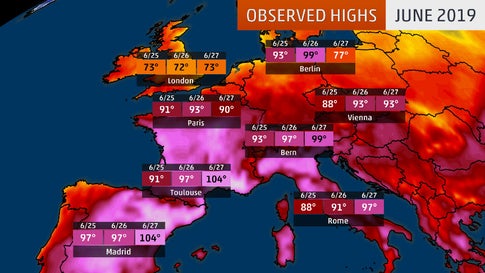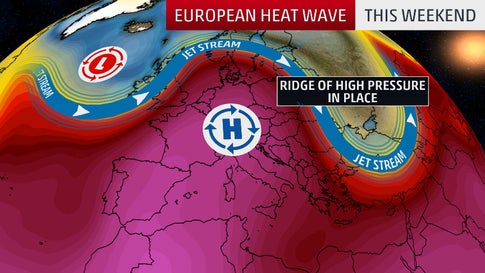By weather.com meteorologists

Current Temperatures(Central European Time)
At a Glance
A major heat wave continues over western Europe.
The all-time record highs for June have already been topped in six European nations.
An area of high pressure in the upper atmosphere is responsible for the extreme heat.
A heat wave currently baking western Europe has already set new all-time June record highs in six nations and an all-time record high in France as the effects of global warming are being felt.
An all-time record high was preliminarily smashed in France on Friday when a temperature of 114.6 degrees Fahrenheit was reported in Gallargues-le-Montueux, in southern France. In addition, at least 12 stations saw temperatures higher than the previous national record on Friday. The previous all-time record high for any month was 111.4 degrees, set on Aug. 12, 2003.
This also marked the first time the 45 degree Celsius threshold (113 degrees F) was reached in France, according to Meteo France and is the hottest day ever measured in June for the country.
France had set a new all-time June record high on Thursday, when Grospierres recorded a high of 108.1 degrees. Previously, the highest fully reliable June temperature in France was 106.7 degrees at Lezignan-Corbieres on June 21, 2003, according to Etienne Kapikian, a meteorologist at Météo-France.
On Wednesday, highs ranged from the 90s to lower 100s in parts of Spain, France, Germany, Belgium, Switzerland, Italy, Austria, Hungary, the Czech Republic, Slovakia and Poland. Berlin and Paris both rose into the 90s, well above the late-June low-70s average high in both capital cities.
For perspective, Berlin is about the same latitude as Calgary, Canada, and Paris is a similar latitude to the border between Montana and Canada.
Wednesday’s all-time June record highs included:
-Poland: 100.8 degrees at Radzyń; tied previous record of 100.8 degrees in Wroclaw in June 1935.
-Czech Republic: 101.3 degrees at Doksany; previous record 100.8 degrees at Brno in June 2000.
-Germany: 101.5 degrees at Coschen; previous record 101.3 degrees in June 1947. Fifty-one individual German reporting stations set new June heat records Wednesday.
-Luxembourg: 98.2 degrees at Petange; previous record 97 degrees on June 22, 2017.
-Principality of Andorra: 98.2 degrees at Borda Vidal; previous record 96.8 degrees in June 1935.
(IN-DEPTH: All-Time June Heat Records Fall)
The hottest temperature in France on Wednesday was 106 degrees at Montclus. One French station with a long-term climate record, Clermont Ferrand, set a new all-time record high for any month at 105.6 degrees.

Actual highs in Europe in late June.
Germany had its hottest June day on record Wednesday. The German weather service reported that 204 of its 451 active stations broke or tied their June record highs, German meteorologist Michael Theusner said in an email to Dr. Jeff Masters, senior meteorologist at Weather Underground. Eleven of those stations broke or tied their all-time record high for any month.
The hottest temperature measured in Germany on Wednesday was 101.5 degrees at Coschen (Brandenburg) and Bad Muskau (Saxony).
In Switzerland, several locations set all-time record highs for any calendar month on Wednesday, including Säntis, Scuol and Davos, according to MeteoSwiss.
According to Météo-France, five locations in France set new June record-warmest low temperatures Wednesday morning, including Nice, whose low temperature dropped to only 78.8 degrees. Another five locations set new record-warm lows for June on Thursday morning and six locations on Friday morning.
Several locations in Spain also set new warmest low-temperature records for June on Wednesday morning.
Germany's highest mountain, the Zugspitze, where weather records extend back to 1900, recorded its all-time warmest low temperature for any time of year Wednesday morning at 54 degrees.
Forecast
Red and orange alerts have been issued in several European countries, including in parts of France, Switzerland, Austria, Luxembourg and Spain to warn about the dangerously hot temperatures, according to MeteoAlarm.eu.
(MORE: France Issues First-Ever 'Red' Weather Alert)
Temperatures are expected to climb into the 90s for much of France, Spain, Switzerland and Italy into this weekend across parts of the continent.
Paris is likely to soar into the 90s Saturday afternoon. Madrid, Spain, could heat up into the mid-100s through Sunday.
Even London will get into the 90s on Saturday.
But some spots in northern Europe will see a cool down on Sunday, including London, Paris and Amsterdam.

Forecast Highs
Temperatures in northern Germany and northern Poland will heat up again over the weekend, possibly approaching their June all-time records once again. Remember, both of those countries just set all-time records for June on Wednesday. Sunday will likely be the hottest day of this heat wave in Germany and Poland.
Some other countries that could come close to June records through the weekend include (record to beat is shown):
-Austria: 101.5 degrees, June 20, 2013
-Switzerland: 99.1 degrees, June 21, 2003
Luxembourg could also approach its all-time June record once again after doing so on Wednesday.
Germany’s all-time record high is 104.5 degrees, set on July 5 and Aug. 7, 2015. On Sunday, temperatures over 104 degrees may occur in parts of eastern Germany, western Poland and the Czech Republic.
Wildfire danger will also increase to extreme levels by this weekend in parts of Europe because of the hot, dry conditions, Masters noted in his latest Category 6 blog post for Weather Underground.
The hot conditions will begin to ease for most of western Europe early next week.
What's Causing the Hot Weather?
The heat is being caused by a blocking ridge of high pressure from near Greenland into western Europe. The setup is related to a negative phase of the North Atlantic Oscillation (NAO) that has prevailed since late April.

The jet-stream pattern over Europe this week is allowing hot air to sweep across much of the continent.
Often a blocking high over Greenland leads to cooler, cloudier conditions in western Europe, but in this case an upper-level trough is positioned over the eastern Atlantic, west of France. The Greenland high is arcing around and to the north of the trough and into western Europe. This topsy-turvy pattern, known as a rex block, can last for a number of days.
"In a negative NAO, it depends where the trough over the Atlantic sits," explains Leon Brown, head of global meteorological operations for IBM Watson Media and Weather. "A little farther west and you get a plume of heat from Africa to western Europe (as this week), or a little more to the east and the heat keeps across central and eastern Europe, with northwest Europe much cooler. There can be a sharp divide, especially for western Iberia, France and the U.K."
Early-Season Heat Waves Are Especially Dangerous
Heat waves are especially dangerous when they occur early in the summer, before people have had time to adapt to the seasonal heat. A 2015 report from the World Meteorological Organization and World Health Organization on heat waves and health notes:
"Heat wave timing appears to have a notable effect on the level of mortality. Heat waves occurring early in the summer have been shown to be associated with greater impacts on mortality in the same population than later heat waves of comparable or higher temperatures (Hajat et al., 2002; Kinney et al., 2008; Anderson and Bell, 2011). The impact of high temperatures later in the summer is sometimes diminished after an early heat wave."
"In Europe, heat waves occurring in June result in relatively high mortality compared to later in the summer, while most high-mortality events in southern Asia appear to occur early in the summer before the summer monsoon."

A resident fo the "Montplaisir" retirement home in the French town of Lyon has a drink in an air-conditions room on August 18, 2009, during a visit from French Secretary of State for the Elderly Nora Berra (not pictured). During the European heat wave of 2003, thousands of elderly people in France died from the soaring temperatures.(Jean-Philippe Ksiazek/AFP/Getty Images)
Europe's biggest heat-wave catastrophe occurred in the first two weeks of August 2003. Great Britain saw its first 100-degree readings in more than 300 years of recordkeeping, and similar temperatures were widespread across Europe. Adding the various national counts implies that more than 50,000 people died as a result of the 2003 European heat wave. Later estimates brought the toll as high as 70,000, though the exact number is difficult to discern. No heat wave in global history has produced so many documented deaths.
A landmark 2004 study led by Peter Stott (University of Reading) found that human-produced climate change made heat waves on par with the European disaster of 2003 about four times more likely to occur.
Just like Algore's algorithim predicted. And in case you forgot, he won the popular vote......
ReplyDelete